On Friday, March 30, 2019, Mark Lakeman spoke to a crowd of over 80 people at Louden Nelson Community Center in Santa Cruz, California. It was a public event, entitled “Imagining the Downtown Commons”, hosted by the Downtown Commons Advocates group and presented by The Campaign for Sustainable Transportation and Santa Cruz Permaculture.
The image above (and Mark's story about it) appears in a video that was made of the event—see the links to it below—along with detailed descriptions of other gathering places that were created in Portland, Oregon.
Mark is a national leader in the development of sustainable public places. In the last decade he has directed, facilitated, or inspired designs for more than three hundred new community-generated public places in Portland, Oregon alone. Through his leadership in Communitecture, Inc., and its various affiliates such as The City Repair Project (501(c)3), the Village Building Convergence, and The Planet Repair Institute, he has also been instrumental in the development of dozens of participatory organizations and urban permaculture design projects across the United States and Canada. Mark works with governmental leaders, community organizations, and educational institutions in many diverse communities.
About the video:
The complete video, as filmed by Josh Stephens, is here. It is long. So in case you may not want to view it all, we have selected a few highlights, with links to them.
Mark tells wonderful stories about the creation of gathering places in the City of Portland, and how such building of community can help to solve a range of problems. The problems? Think of reducing the use of (and need for) private cars, integrating homeless people into the community, and providing low cost housing for those who need it. Most of all, it helps people connect with each other. Mark quotes an eleven-year-old girl: “It makes me feel like the whole city is my home.”
Davis City Council favors a Farmers Market by only one vote:
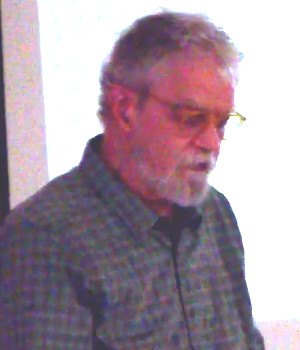
John Hall
Mark was introduced by John Hall, a Downtown Advocate who came to Santa Cruz not long ago from Davis, California. John himself tells an interesting story about the creation of the famous Farmers Market in Davis. He notes three points: (a) The Farmers Market is on the site of what was formerly a parking lot. (b) The alternative plan for this space was a combination of a shopping center and a parking garage. (c) Despite the overwhelming support of the Davis citizens for a Farmers Market, the Davis City Council voted only 3 to 2 to move forward with creating a civic park and expanding the Farmers Market facility. Click here to listen to John's exact words.
Why are our streets laid out as a grid?
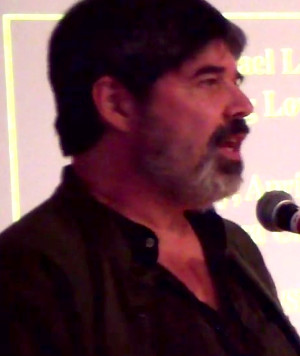
Mark Lakeman
Why do we have, particularly in the cities of the West and Midwest, the pattern of streets that are laid out as a grid? Here are Mark's words:
“Retro-fitting the American landscape with places for people to gather is a greater challenge than in any other country across the spectrum of the world.”
“Most people don't even know about the National Land Ordinance of 1785, when the way that we would expand to the [Pacific] Ocean was formulated. And it was formulated as a great document—before the declaration of the Constitution and the Bill of Rights were created—and yet it proscribes the way that our land was developed according to a grid that organizes space, and that land is commodified automatically within that framework.” If you would like to listen to Mark, click here.
Is this community?
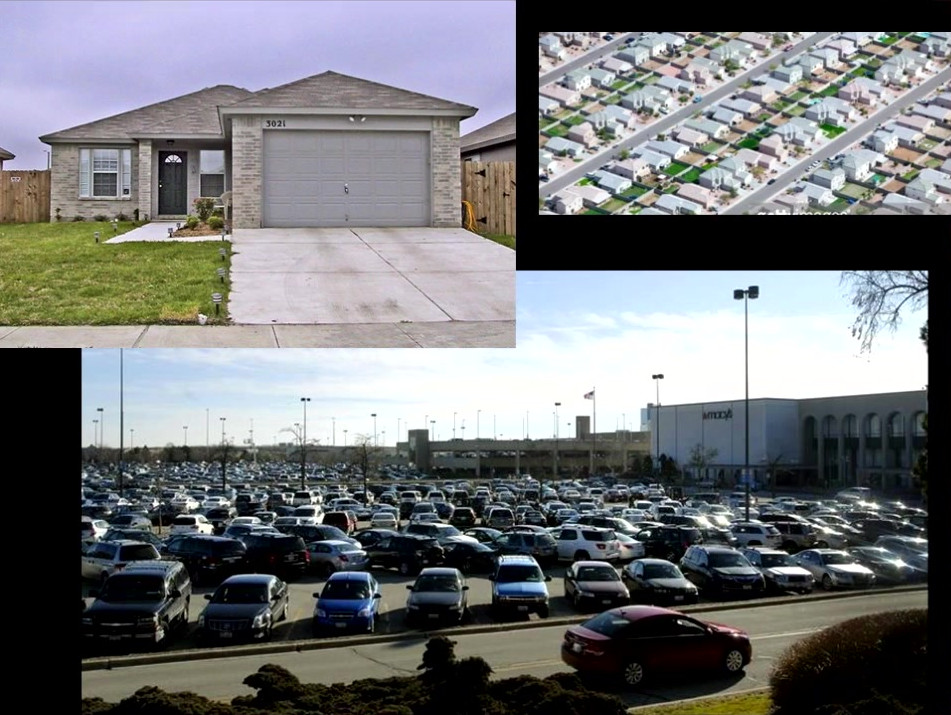
Think about this
This is what we have to start with. Do you see any people? Any bicycles? The dominant features in front of the house are the garage door and the driveway. Is this community?
Here is what Mark says: “I tell you, in America, because we treat human landscapes more as commodities than as community places, we design our own problems.”
To hear what Mark has to say about this scene, click here.
The start of a gathering place:
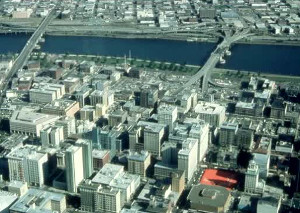
Red garage top
OK. Have a look at the image in the header of this page, up at the top. What's that mostly red surface, with the people standing around? Well, it's the top of a two-story garage in the center of Portland. If you look carefully at the aerial view at the upper left of the image (duplicated here), you can see that red garage top, right there in the midst of all the tall buildings.
Mark has a good story about all this. You can listen to it here.
“It makes me feel like the whole city is my home.”
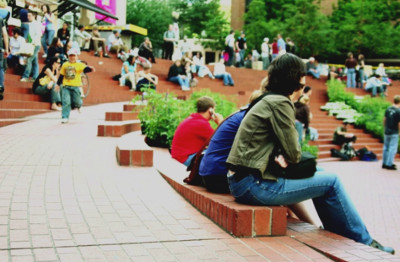
A gathering place
It was a challenge, but after the Mayor of Portland was replaced by one more favorable to community, the two-story garage was replaced by a marvelous gathering place, one that was designed by extensive community participation. Its official name is the “Pioneer Courthouse Square”. It gets top-rated reviews from both visitors and residents.
Mark describes the transformation, and quotes an eleven-year-old girl who exquisitely summarizes—with a single sentence—the feelings of everyone. You can listen to him here.
A chess metaphor:
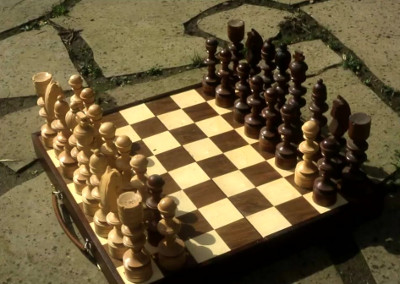
Watch this chess game
Here Mark describes one of his favorite metaphors—what happens when the pawns get smart, and realize that the game—as designed by the kings and queens and their minions—is sure to end, usually with a victory by one side or the other. The game is therefore not sustainable, but the pawns figure out a solution.
This is a fairly long segment, but it's worth watching. It's entertaining and instructive. Click here to watch it.
Portland's grid: Lots of intersections
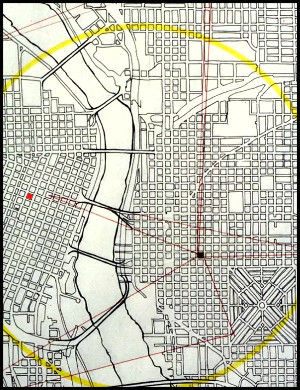
A map of Portland
That's the Willamette River flowing North through Portland, toward the Columbia River. Downtown is to the left (West) of the river, and the much-loved Pioneer Courthouse Square (pictured above) appears as a red dot in the middle of downtown.
Mark says, “When we were looking at retrofitting the city with public squares, we looked at the fact that the typical Portlander had to move all across the landscape just to get their needs met every day. So we asked ourselves: How much more could we accomplish if we enabled people to be connected to those around them?”
Following this line of thinking, Mark and others who worked with him arrived at the strategy of allowing street intersections—which, after all, are community property—to be used as community gathering places.
Click here to hear what he says.
Intersections:
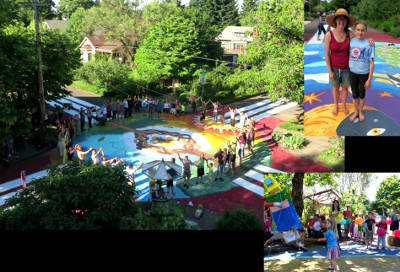
Is this a weird idea?
In this seven-minute segment—it's best here to continue watching all the way to the formal end of Mark's presentation, just after the 50-minute time marker—Mark first describes how the idea of allowing a street intersection to become a community gathering place amazingly went viral, to the extent that it became endorsed and encouraged by the City Council and City Staff.
Along the way is a description of the creation of living places for homeless people and others in need of low-cost housing.
Click here to hear what Mark says.
Personal stories from Mark:
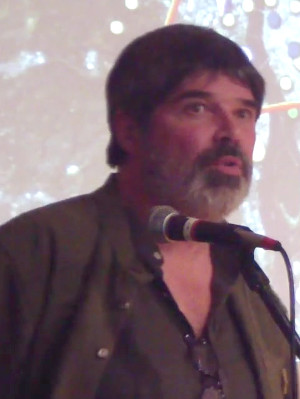
Mark, telling stories
After Mark's presentation, when there was opportunity for questions, he told a couple of stories. He introduced the first one by saying, “Something happened that was remarkable, and it propelled me into this issue forever, and I will not walk away.” His second story involves Albert Einstein's granddaughter.